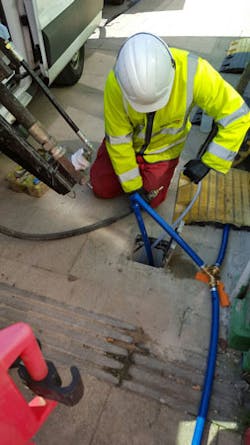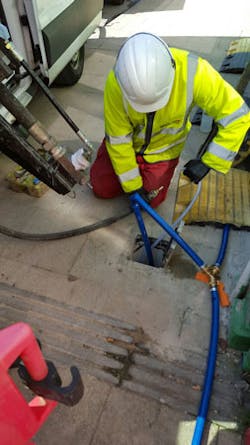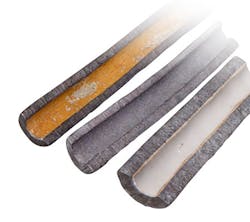Learning from the Flint Fiasco: The Case for Lead Pipe Upgrades
A landmark paper on lead pipe rehabilitation and replacement techniques was published by the American Water Works Association in 2001. One of the members of the original project advisory committee has revisited the report and here presents a timely update.
By Nick Preston
It is 15 years since the Lead Pipe Rehabilitation and Replacement Techniques (2001) report was published by the American Water Works Association (AWWA). Since its publication, there have been significant changes to global and national regulatory limits for lead in drinking water as scientists have become better informed about the risk posed to public health, especially in young children’s brain development.
The issue has risen swiftly up the news agenda following revelations of exposure to lead in drinking water by people living in the US city of Flint, Michigan. Importantly for utilities concerned about their exposure to risk and wanting to take action, there has also been significant development and commercialisation of viable technologies for pipeline rehabilitation, which have yet to be widely adopted by utilities and their supply chain contractors.
Public and local authorities, as well as owners and occupiers of public buildings, have a Duty of Care to ensure that the water is safe to drink and free from contamination with lead leached from their pipework.
Multifaceted research
In 1994, UK water company North West Water (now United Utilities) started a portfolio of research and technology projects aimed to significantly reduce the exposure of customers to lead in water supplies. Projects were undertaken on a range of topics: to replace the lead service pipes with minimal disruption, to line lead pipes with barriers and to adjust the water chemistry to limit its plumbosolvency - the extent to which water picks up lead molecules from lead pipe.
The AWWA funded a project to generate a document that would enable water utilities and their contractors to select lowest whole-life cost, most technically appropriate solutions to end a customer’s exposure to lead in their water supply. North West Water provided an industry expert for the Project Advisory Committee and supported case and field studies on which the research was based. In addition to the comprehensive research report a working document - Lead Pipe Rehabilitation and Replacement Techniques - was produced.
Regulatory changes
In the period since the research was carried out, the World Health Organisation (WHO), the US Environment Protection Agency (EPA), the EU and their associated national regulatory bodies have all reduced regulatory limits from 50 micrograms per litre.
They were then further reduced to 25 micrograms and most recently to 10 micrograms in 2015. Variations in methods of taking samples from customers’ taps mean there are different implications relating to the actual exposure of a particular customer.
For example, the US Lead & Copper Rule methodology is significantly different to that used in the EU and Canada. Variations may include:
- Whether water is stagnated in the pipe or flushed before sampling
- Volume of the sample and other parameters of the property
- Statistical methodology of random pipe or property selection.
Utilities found that an adjustment of pH, improvements in water quality (including colour and turbidity) and also the introduction of phosphate could significantly reduce the propensity of any water supply to reduce plumbosolvency to the point at which 10 micrograms per litre could generally be achieved. However this would not be the case if significant amounts of particulate - rather than soluble - lead were present.
On those occasions where water sources were changed due to supply constraints or cost optimisation, the changes in water chemistry could result in significant release of particulate lead along with iron and manganese from the pipe wall.
Barrier techniques
The people of Flint, Michigan and Sebring, Florida have recently been exposed to elevated lead levels in their drinking water due to short-term changes in the water chemistry. The only long-term solution is to stop drinking water coming into contact with lead, either by removing any lead pipe and lead-based solder, or by creating an impermeable barrier of epoxy or other polymeric lining.
Since North West Water’s early work, patents on lining lead service pipes and associated communication pipes, or extracting the lead pipe from the ground and simultaneously inserting a new polyethylene pipe, have expired. The selection of the lowest whole-life cost solution, that meets the customer’s need, remains the objective.
The development and commercialisation of those techniques advocated back in 2001 have become viable solutions. Unfortunately they have not been as widely accepted by utility operators or their contractors as they could have been. The implications for customers’ health and child development can be seen with incidents such as Flint, and are most probably happening on a smaller scale in any country with lead supply pipes
Technology performance
There have been significant availability and commercial improvements in techniques for pipe cleaning and lining over the last 15 years. This includes the ability to rehabilitate smaller diameter pipes.
Improvements in pipe-bore cleaning techniques mean that the interior walls of supply pipes can now be prepared for lining to a higher standard. This means cheaper operational costs for utilities.
Improvements in resin compounding mean better adhesion and improved curing times during epoxy pipelining installations. This results in a more homogenous lining than those trialled by the AWWA in 1999/2000.
The capability to line smaller lead communication pipes at the same time as the customer’s supply pipe means a much more efficient programme of works with less risk of unplanned activities or damage to customer’s internal decoration, fixtures and fittings. For example, Serline by Aquam demonstrates these efficiency improvements and can now be shown to deliver the improvements in lead reduction expected by customers.
A lead-reduction strategy should consider the risk ratio and cost benefit of a lead pipe replacement and lining programme targeted at private housing stock as well as public premises where high risk customers use a particular building, for example, nursery schools, ante-natal clinics, GP and midwifery practices.
A lead-reduction programme of domestic properties with the highest public health risk, for example, where pregnant women and young children are resident, would start with detailed analysis to identify the likelihood of there being a complete lead service pipe in place. This would take account of property type, age and other factors.
Analysis of water quality by water supply zone is unlikely to be sufficient to identify individual properties at risk in specific streets or postcode areas. An inspection of boundary stop-taps and possibly internal plumbing inspections would identify actual properties with lead pipes that are owned by the public utility company and need to be replaced or epoxy-lined.
The Water Industry Specification 4-02-03 Draft - Operational Requirements: In Situ Polymeric Lining of Service Pipes is underway. Once complete, it should also act as a catalyst for all UK water utilities to ensure they limit their customers’ exposure to lead and eliminate their risk of an incident akin to that in Flint, Michigan where chemical addition has failed to be a long-term solution. Owners of public buildings can now be offered a highly cost-effective solution to mitigate their risks and carry out their duty of care to building users.
Learning from Flint
The recent press attention to the issues around lead contamination and the impacts on public health brought about by the incidents at Flint and Sebring will no doubt focus the attention of many water undertakers across the world.
It is also expected that the owners and occupiers of public buildings recognise their Duty of Care towards their users. They too should be made aware of highly efficient and effective ways to reduce lead exposure. The AWWA method selection provides a basis from which those concerned can approach their supply chain to determine the least cost alternatives available to them.
Nick Preston was a member of the Project Advisory Committee for the AWWA report Lead Pipe Rehabilitation and Replacement Techniques and is an inventor of patented lead pipe replacement techniques.
More Water & WasteWater International Archives Issue Articles


